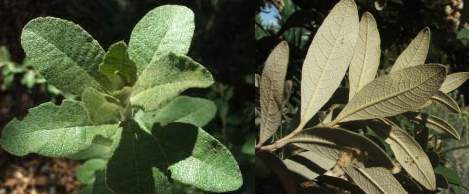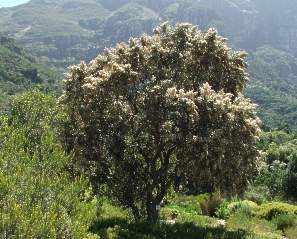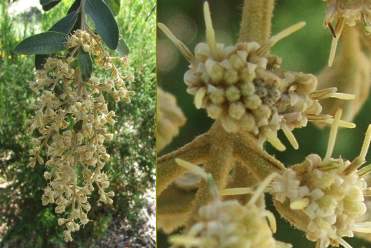Tarchonanthus littoralis
Tarchonanthus littoralis P.P.J.Herman
Family: Asteraceae
Common names: coastal camphor bush ( Eng. ); kuskanferbos (Afr.); isiduli selindle (Xhosa); igqeba-elimhlophe, isidulu-sehlathi (Zulu)
SA Tree No: 333.2
Introduction
For a small evergreen tree that will thrive in windy, coastal conditions, through drought, and in nutrient-poor, sandy soil, look no further than Tarchonanthus littoralis. Readers may know it better as T. camphoratus, but a recent study has shown that T. camphoratus was made up of five distinct species that have now been individually named and described. The revised T. camphoratus occurs in the northern part of southern Africa whereas this recently defined species occurs along the south and southeastern coast of South Africa.

Description
Description
Tarchonanthus littoralis is a large, dense, bushy shrub or small, shapely tree, 1-8 m tall. The trunks are often crooked, and the trees often multi-stemmed. The bark is vertically fissured and cracked, flaking off in narrow strips. Young growth is densely hairy. Leaves are strongly aromatic and leathery. The colour of the upper and lower surfaces of the leaves are distinctly different: the upper surface is dark green, hairy when young but becoming hairless; the lower surface is white-grey and covered in a dense mat of velvety hairs. The main vein is sunken, particularly in the lower half and the leaf contains a fine network of veins, which is clearly visible on both surfaces. The margin is very often faintly and minutely toothed in the upper part (on the Kirstenbosch plants, this is most easily seen on the young coppice growth).

Tarchonanthus littoralis is dioecious, meaning that the male and female flowers are carried on different trees. Peak flowering time is during mid to late summer (December-March). On both male and female trees, the individual flowers are borne in small flower heads which are grouped into large, branched, terminal inflorescences. Male flower heads are 5-10 mm in diameter and contain 13-47 flowers, each tiny flower a 5-lobed, funnel-shaped tube, ± 3 mm long, with recurved corolla lobes. The anthers are ± 1.5 mm long and protrude beyond the tube. The male flowers have a sterile ovary and a long, protruding style (up to 8 mm), which is a noticeable feature of the flowers. The anthers are the striped structures surrounding the base of the style.
The female flower heads are ± 5 mm in diameter and are made up of only 3-6 tiny flowers. Each flower is a 5-lobed, funnel-shaped, ± 2 mm long tube with recurved corolla lobes. The style is ± 3 mm long with 2 short branches, and protrudes beyond the corolla lobes. The fruit is an achene, ± 4 mm long and is densely covered in white, woolly hairs.

Both the male and female flowers are white to cream-coloured but the bracts that surround the flowers and the stalks are creamy brown and so the overall colour of the inflorescence is a yellowish cream and the trees are attractive while in flower. A month or so after flowering, each female flower has become a cotton-wool-like ball of shiny white fragrant hairs, that fluffs out more as it matures. The small seed is buried inside the puff of white hairs. The brown star in amongst the woolly hairs is the remains of the corolla tube and style. The white fruiting inflorescences are extremely showy against the dark green foliage, and remain decorative for many months. While the female trees are still looking beautiful, the male flowers are dead and brown and the male trees are quite drab in comparison.
Conservation Status
Status
Tarchonanthus littoralis is not threatened.
Distribution and habitat
Distribution description
Tarchonanthus littoralis occurs from the Cape Peninsula in the Western Cape, along the coast, on hillsides, dunes and river banks, through the Eastern Cape to KwaZulu-Natal.
Derivation of name and historical aspects
History
There are two possible explanations for the name Tarchonanthus : one, that it is based on the Arabic name tarchon for tarragon, Artemisia dracunculus, and the Greek, anthos, meaning flower, alluding to the similarity of the flower heads of the two species; the other, that it is from the Greek, tarchos, meaning funeral rites, perhaps due to the camphor scent of the leaves. The species name littoralis is from the Latin litoralis and means of the shore, seashore or coast, alluding to its coastal habitat. Both the leaves and the wood have a strong smell of camphor, hence its common name.
Tarchonanthus belongs in the daisy family. It is a small genus of a few species that occurs in tropical and southern Africa. Until recently, only two species were recognized in southern Africa: Tarchonanthus camphoratus and T. trilobus, but P.P.J. Herman (2002) of the National Herbarium in Pretoria, after studying the herbarium material, found that five distinct species had been grouped under T. camphoratus, and today we recognize six southern African species of Tarchonanthus.
Herman's 2002 revision of the Tarchonanthus camphoratus complex is based on differences in inflorescences, flowering times, leaf shape, leaf margin and distribution. The five species that were all once lumped together under T. camphoratus are now recognized as follows:
T. camphoratus, camphor bush, is widely distributed in a variety of habitats in the northern part of southern Africa from Namibia, Botswana, Limpopo, North-West, Gauteng, Free State and Northern Cape as well as in tropical and north Africa and the Arabian Peninsula. It has narrowly elliptic to slightly oblanceolate, grey-green to khaki green leaves with an entire margin, 26-80 x 7-20 mm, and the cottony hairs that envelop the seed are yellowish or cream-coloured. It flowers in autumn to winter, and it is not browsed by stock except as a last resort.
T. minor, small-leaf camphor bush, occurs in the Free State, Lesotho, Northern Cape and inland in the Western and Eastern Cape. It has very small, narrowly elliptic leaves, 10-40 x 2.5-15.0 mm, flower heads in dense clusters, and the cottony hairs that envelop the seed are white. It flowers in spring to early summer.
T. obovatus, Gordonia camphor bush, is restricted to the Northern Cape. It has small, obovate or elliptic, entire leaves, 12-32 x 7-17 mm, and the cottony hairs that envelop the seed are pure white. It flowers in autumn to early winter and it is readily browsed by game and domestic stock.
T. parvicapitulatus, small-headed camphor bush, occurs in Limpopo, Swaziland, KwaZulu-Natal, Eastern Cape and in Zimbabwe. It has small, oblanceolate leaves, 25-60 x 7-16 mm, with faintly denticulate margins in the upper part, and the cottony hairs that envelop the seed are white. It flowers in autumn to winter.
T. littoralis, coastal camphor bush, is most easily distinguished from the others by its much larger, oblanceolate, elliptic to narrowly elliptic leaves, 40-140 x 10-45 mm, and large fruiting heads.
Ecology
Ecology
Tarchonanthus littoralis is pollinated by insects. The fruits are encased in light, cottony hairs and are dispersed by wind. The cottony hairs make the seeds buoyant, which allows them to float for some time. This would enable seeds from plants growing along the coast or beside rivers that fall in the water, to be washed ashore again and to find a suitable place to lodge and germinate, instead of sinking, germinating and dying under water. The cottony hairs may also assist the seed in finding suitable sites to germinate by sticking to wet soil when it happens to land on wet soil.
Tarchonanthus littoralis, if cut down or burned but not killed by a fire, will resprout from the base.
Tarchonanthus littoralis is important in binding sand on coastal dunes. It is a valuable source of food for wild animals and domestic stock.
Uses
Use
The five species that made up the Tarchonanthus camphoratus complex are widely used in traditional medicine. The leaves and twigs are used, either drunk in a tea or chewed fresh, to treat headaches, asthma, bronchitis, coughs, colds, flu and other chest ailments, rheumatism, internal bleeding, anxiety, indigestion, heartburn and other stomach troubles, and to relieve toothache. An ointment made with the leaves is used to soothe chilblains and sore feet and sometimes used to massage the legs before a long journey. In combination with wild sages, the Khoisan people used them to treat fevers and measles.
The Khoisan people used to smoke the leaves as a dagga substitute (hemp, marijuana). The leaves are tied into hair to perfume the hair or rubbed into the scalp to keep the hair free of nits and dandruff or just for the perfume. Leaves and twigs are used as an insect repellent among clothing and linen. The fragrant, cottony seed heads are used to stuff cushions and pillows, which are said to be excellent for headaches and sleeplessness. Leaves tucked under the pillow are said to ensure a peaceful night. The wood burns, even when green, giving off a perfumed smoke. Burned leaves and seeds also give off perfumed smoke and are used to fumigate huts, and smoke is inhaled to treat rheumatism, headaches and sleeplessness.
The wood is heavy and fairly hard, tough and termite-proof but is difficult to season and chop. It polishes well and has been used for musical instruments, cabinet work and is suitable for turnery. It is used for boat-building and to make yokes and yoke pins. It has also been used for the shafts of spears and bows, and for walking sticks. It makes a durable fence pole, said to stand for 30 years. The wood is said to be poisonous and capable of causing a septic sore on the skin that heals with difficulty.
In Griqualand West, the old tradition was to surround the homestead with an outer fence made of thickly woven camphor bush sticks.
In the modern home, its long straight coppice growth can be cut and used as sturdy garden stakes. Its leaves and seed heads can be used in potpourri or to perfume clothing or linen cupboards.

Growing Tarchonanthus littoralis
Grow
Tarchonanthus littoralis is a quick-growing, small, dense tree. It has the ability to survive and thrive under harsh conditions that many other plants cannot tolerate. It can be planted to provide a windbreak, as a pioneer in a new garden to provide shade, and to bind the sand. Tarchonanthus littoralis also has excellent proportions for small suburban gardens, never getting too big, with a decorative trunk and shapely crown. It grows right beside the sea and tolerates salt spray, which makes it tailor-made for coastal gardens. It is ideal for difficult sites on the Cape Flats where it thrives in the nutrient-poor sandy soils, strong wind and summer drought. It is water-wise and can be planted in dry areas or in gardens that are not irrigated. It also does not mind being pampered in the average suburban garden.
Plant in well-drained soil in a sunny position. Give it a good start with plenty of compost and water in its first few years. Once established, it requires very little attention. Prune to shape when young or keep tidy as it matures, and remove unwanted shoots from the base to keep the trunk clear.
Gardeners looking for a female plant for the decorative fruiting heads, should either buy a plant bearing fruit, or learn to tell the difference between the male and female flowers. To achieve pollination and viable seeds, one must plant a male and a female tree.
Tarchonanthus littoralis can be propagated by seed or cuttings.
Seed is best sown when ripe in late summer to autumn or stored dry and cool and sown in spring to early summer. Seed is ripe when the fruits detach easily from the inflorescence, either by gently pulling or knocking them off. The seeds in their cotton balls can also be picked up from under the tree. It is virtually impossible to remove the seeds from their woolly covering and they can be sown with hairs still attached. Use a well-drained medium, sow the seeds thickly in a single layer and cover them lightly to stop them from blowing away. Germination takes 4-6 weeks with a 70-80 % success rate. Seedlings can be transplanted as soon as they are strong enough to handle.
Take semi-hardwood cuttings in early summer, treat with a rooting hormone and place under the mist with bottom heat. Tarchonanthus littoralis takes a while to root and on average only half of the cuttings taken will root.
References
- Coates Palgrave, M. 2002. Keith Coates Palgrave Trees of southern Africa, edn 3. Struik, Cape Town.
- Herman, P.P.J. 2002. Revision of the Tarchonanthus camphoratus complex (Asteraceae-Tarchonantheae) in southern Africa. Bothalia 32: 21-28.
- Jackson, W.P.U. 1990. Origins and meanings of names of South African plant genera. University of Cape Town Printing Dept, Cape Town.
- Leistner, O.A. (ed.). 2000. Seed plants of southern Africa : families and genera. Strelitzia 10. National Botanical Institute, Pretoria.
- Palmer, E. & Pitman, N. 1972. Trees of southern Africa. Balkema, Cape Town.
- Pooley, E. 1993. The complete field guide to trees of Natal, Zululand and Transkei. Natal Flora Publications Trust, Durban.
- Roberts, M. 1990. Indigenous healing plants. Southern Book Publishers, Halfway House, Gauteng.
- Smith, C.A. 1966. Common names of South African plants. Memoirs of the Botanical Survey of South Africa No. 35.
Credits
Alice Notten
Kirstenbosch National Botanical Garden
April 2008
Plant Attributes:
Plant Type: Shrub, Tree
SA Distribution: Eastern Cape, KwaZulu-Natal, Western Cape
Soil type: Sandy, Loam
Flowering season: Late Summer
PH: Acid, Neutral
Flower colour: Cream
Aspect: Full Sun
Gardening skill: Easy
Special Features:
Horticultural zones












Rate this article
Article well written and informative
Rate this plant
Is this an interesting plant?
Login to add your Comment
Back to topNot registered yet? Click here to register.